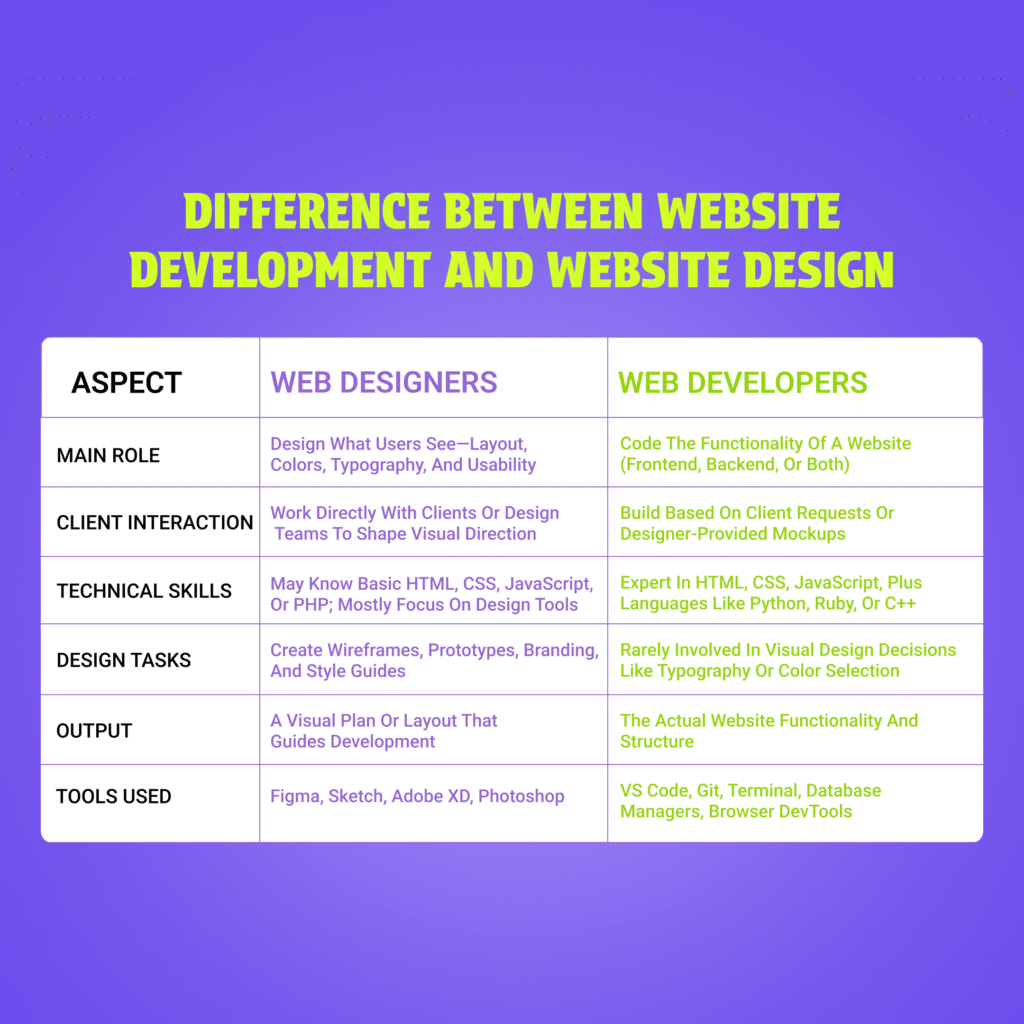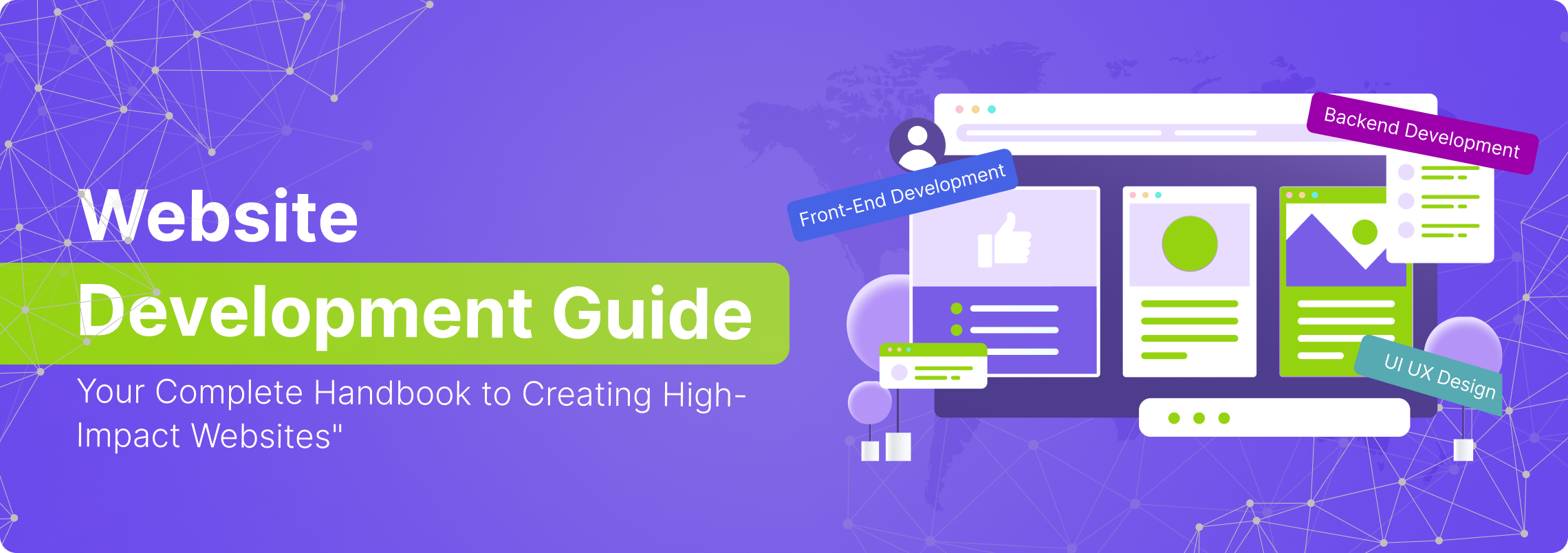- Written by: Nora James
- July 25, 2025
- Categories: Web Development
It may surprise you to learn that there are over 2 billion websites on the internet.
The reason is that every business aspires to become an expert in the digital sphere. As a leading provider of custom web development services, Evomations is well-versed in web services.
This guide covers the definition of web development, types, technologies, common programming languages, and development process. Read on to learn everything about website development.
Understanding website development
Website development is the process of building and managing websites on the internet. It includes designing and creating websites that users may access online using a variety of programming languages, tools, and software.
Web development includes a variety of elements, such as:
- Front-end development which concentrates on creating the website’s user interface through design and development.
- Back-end development, which handles the server side of the website, including web application programming, database administration, and server configuration.
What makes web development important?
Web development is essential in today’s digitally driven environment. A website is an essential internet presence for organisations. It enables them to connect with a worldwide audience. It functions as a 24/7 online shopfront. Websites are used by people to share their ideas, works of art, and portfolios. Organisations use websites for service delivery, communication, and information sharing.
Essentially, web development enables people and organisations to communicate, do business, and exchange information with ease. It powers social networking, online learning, e-commerce, and a host of other online endeavours. A well-designed website increases trust, boosts client interaction, and spurs expansion.
How can web development help your business?
Here are the two most effective ways web development may help your organisation grow.
Keep up with the latest trends
As technology advances, organisations are unable to keep up with the latest trends and technologies. Web app development is an effective approach for organisations to keep up with current developments.
Allows for easy navigation
It can help you create a user-friendly business website. Having a website that performs well might help you establish a solid connection with your clients. It will eventually lead to massive sales in your company.
In a nutshell, web development may improve accessibility, create more leads, boost business efficiency, and establish brand identification.
Difference between website development and website design
Although web design and web development are closely related, they address separate facets of website creation, each requiring a different set of abilities and concentrating on different goals.
The following table defines the role of website developers and designers:

Web development fundamentals
All websites, no matter how complicated, are built on a few basic components. Web developers use these fundamental technologies on a daily basis.
HyperText Markup Language, or HTML
It can be thought of as a website’s structural backbone. It gives web pages their content and significance. Developers define headlines, paragraphs, images, links, and other content components using tags and elements. Information is arranged in HTML for browsers to comprehend and display. It builds the webpage’s framework. A webpage would only be plain text without HTML.
Cascading Style Sheets, or CSS
It takes over the visual presentation after HTML has been established. A website’s appearance and feel are managed by CSS. It determines responsiveness, layouts, colours, fonts, and spacing. HTML elements are styled by developers using CSS rules. This guarantees a consistent and aesthetically pleasing user experience on a variety of screens and devices. CSS makes websites easier to update and manage by separating the design from the information.
JavaScript (JS)
JavaScript is necessary to give webpages dynamic behaviour and interactivity. It is a robust scripting language that is compatible with web browsers. With JavaScript, developers can build dynamic content changes without requiring page reloads, interactive maps, animations, and form validation, among other captivating features.
Web development types
Three primary categories can be used to broadly classify web development: full-stack, backend, and frontend development. Each type has diverse skill sets and responsibilities and focuses on different facets of website construction and functionality.
Frontend development
Frontend development is mostly concerned with the area of the website that visitors directly interact with. Frontend developers are in charge of creating the visual components that users interact with and view in their web browsers. This include creating the layout, adding visuals, and making sure it works on a range of devices.
To create a smooth user experience, frontend developers use languages like HTML, CSS, and JavaScript. They aim to improve the user experience by ensuring that the website is aesthetically pleasing, simple to use, and responsive across all platforms.
Backend development
Back-end development involves the integration and logic of server-side web applications. The back-end developers concentrate on the backend features that enable frontend functionality. This covers database administration, programming, and website architecture. They guarantee the proper delivery of any data or services that the frontend system or application requests.
Python, Java, PHP, Ruby, and other programming languages are frequently utilised in backend development. In order to make sure the website can effectively handle expected traffic volumes, backend developers also tackle security, data management, and scalability challenges.
Full-stack development
Full-stack development gives developers the ability to manage every facet of a project by combining their expertise in frontend and backend development. Full-stack developers possess a thorough understanding of web applications’ client and server sides.
They can lead teams or manage projects individually, thanks to their dual competency, which also allows them to make architectural decisions and maximise performance on both ends. They can troubleshoot and solve issues throughout the whole development stack because they are proficient in a variety of programming languages and frameworks.
Every kind of web development is essential to building dependable, expandable, and user-friendly websites. Backend development makes sure the website runs safely and dependably, whereas frontend development concentrates on user engagement and experience. By bridging these two domains, full-stack development provides a comprehensive solution to web development problems.
The top 9 technologies for web development
Below, we’ll look at some of the top web development tools that are frequently used to create high-performing web apps. The technologies are very popular among web developers because they make it simpler to create dynamic, useful, and user-friendly websites.
1. Angular
Google released the robust Angular framework in 2016. It is well known for its two-way data binding capability, which facilitates data synchronisation between the backend and the user interface.
With its extensive ecosystem of frameworks and tools, Angular is ideal for creating dynamic web applications. Angular is used by many popular websites to provide reliable and seamless performance.
2. React.js
One of the most widely used frameworks for creating contemporary web applications is React.js. One-way data binding, which React uses in contrast to Angular, streamlines the data flow within an application.
It has outstanding server-side rendering capabilities and works well for both small and large applications. React is a popular choice for companies who want their websites to rank highly on search engines because it also supports SEO.
3. Yii
Yii is a simple yet effective open-source PHP framework. It has many tools for testing your apps to make sure they function flawlessly before going live.
The best feature of Yii is its ease of use, especially for novices. It is an excellent option if you’re searching for a PHP-based framework that completes tasks quickly.
4. Laravel
Another open-source and free PHP framework that is very well-liked among developers is Laravel. It adheres to the Model-View-Controller (MVC) framework, which facilitates code organisation.
Laravel makes automated testing, caching, and user authentication easy tasks. It is perfect for creating high-end web apps because of its sophisticated syntax and abundance of features.
5. Meteor JS
A JavaScript framework based on Node.js is called Meteor JS. It is intended for the development of real-time online applications in which users can see updates instantly.
Meteor generates code that functions on both the frontend and backend and is cross-platform. For developers seeking speed and flexibility, Meteor is a good option because of its robust community.
6. Zend
A PHP-based framework called Zend is ideal for creating dependable and expandable web applications. For large-scale projects that demand performance and stability, it is very helpful. Because Zend offers a wide range of customisation options, developers working on intricate enterprise-level applications frequently choose it.
7. Django
The Python-based framework Django has existed since 2005. Its simple and practical design streamlines the web development process and adheres to the MVC architecture.
Due to its many capabilities, scalability, and security, Django is frequently utilised for large-scale applications. Django can help with any size project, from tiny projects to large platforms.
8. Vue.js
Introduced in 2014, Vue.js is a relatively new framework that has rapidly acquired popularity. It offers a lightweight structure and two-way data binding, combining the best aspects of React and Angular.
Vue.js is excellent for creating end-to-end apps and has a robust community. Developers love it for its ease of use and adaptability.
9. Express.js
Developed in 2010, Express.js is a simple yet incredibly reliable framework. It is ideal for full-cycle web application development and adheres to the Model-View-Controller (MVC) pattern.
Express.js is quick, light, and compatible with Node.js. It is a mainstay in the field of web development due to its dependability and simplicity.
Website development process
A web development process is a set of documented steps used to finish a project or web application. Often referred to as a web development lifecycle, it assists in coordinating web development resources, stakeholders, and other team members to guarantee that each project component is taken care of and completed on schedule.
Below, we will examine the steps of the web development lifecycle.
1. Gathering the requirements
Prior to developing a website, concentrate on compiling all the information needed for the project. This contains the development’s primary goal, objectives, target audience, and salient features.
Above all, you need to have a goal or reason for creating the website. You should be aware of if the company specialises in a particular field, provides a variety of services, or offers product details.
2. Planning
Planning comes next after you have information and know what to do. Then, you need to make a project sitemap that requires you to analyse the necessary data. You can visualise the website and how to make it user-friendly for people with basic functionality with the aid of the sitemap.
In order to finish the project, you also need to decide on the web development platforms, languages, frameworks, software development technique, budget, cost estimation, and resources. UI/UX design, wireframing, layout planning, and content production are also included in this planning phase.
3. Designing
This is the most important stage because it has a direct impact on the website’s UI/UX. Making your website responsive across devices is also the most important web design fundamental. Web designers incorporate graphic elements, information, layouts, navigation, photos, and videos to create a feature-rich and user-friendly website.
Therefore, to integrate the newest technology, frameworks, and design elements into effective designs, web designers must keep up with the most recent developments in web development.
4. Development
The website’s development is a major undertaking that calls for technical expertise in web development languages and frameworks. The three main processes that comprise this phase are as follows:
- Writing content: It involves conveying the correct message to your audience, which may include call-to-actions, an explanation of your product or service, and corporate details.
- Front-end development: The development of the client side is the focus of front end development. It converts early-stage concepts into animations and effects to demonstrate how your website will engage with users.
- Backend development: It is necessary to display the information that users have requested. It makes it possible for the user and server sides to communicate.
5. Deployment and testing
Make sure to thoroughly test a website before launching it to the public. Our team of testers and QA specialists at Evomations uses a wide range of QA and testing tools for web and server-side systems to verify a variety of features, including usability, compatibility, performance, and functionality.
This phase ensures that your website is market-ready and functions flawlessly. Nonetheless, the development team may carry out tasks like page performance optimisation, on-page SEO, and plugin installation.
6. Assistance and maintenance
The development process doesn’t stop when your website is online and is deployed. After the deployment, more work needs to be done. This phase includes website maintenance, performance and update analysis. To establish a long-term relationship with your clients and increase the project’s visibility at this point, ongoing support is necessary.
Planning to use web development for your project?
You now have a thorough understanding of web development and understand its significance for your company. The majority of firms use cutting-edge website creation technologies to create responsive, SEO-friendly websites.
If you have questions and are preparing to begin a web app development project, ask one of our skilled and committed web developers for help.
Speak with our knowledgeable web development professionals. Together, we can create a reliable web solution for your business.
Want a unique website for your business?
Let Evomations help you build a powerful, user-friendly website that stands out.


